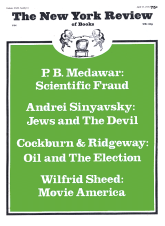In response to:
Summoning Up the Kabbalah from the February 19, 1976 issue
To the Editors:
Harold Bloom is more than capable of replying to Leon Wieseltier’s criticism of Kabbalah and Criticism (NYR, February 19); but someone should object to the use of Bloom’s surname as occasion for bad Joycean punning. That sort of incivility went out at Oxford in the nineteenth century when undergraduates drew applause by referring to Aristotle’s Poetics as having been Butchered, or to fellows of Leon Wieseltier’s (what an aspiring undergraduate could do with that oxymoron) own college as “sons of Belial.” As Mario Puzo and other chroniclers of changing tastes have reminded us, we expect more restraint from our dons these days.
As to the “nonsensical dust jacket” claiming this book to be “the cardinal work in Harold Bloom’s critical enterprise,” the word “cardinal” was not used to mean “most important” or even “major,” but merely and quite radically that this is the “hinge” book, the book that connects past and future achievement. Maybe this is a “nonsensical dust jacket” to Mr. Wieseltier because, with the naïve literalism that characterizes most of his review, he feels a “cardinal” work should have a red dust jacket, whereas this one is blue.
Justus George Lawler
Editor in Chief
Continuum Books, Seabury Press
New York City
Leon Wieseltier replies:
I never denied that Barnett Newman was familiar with Kabbalistic lore, nor even that its images and ideas are occasionally reflected in his work. Mr. Hess’s stimulating monograph did indeed incontrovertibly establish that. My objection, however, was that it was Mr. Hess who was being carried away in his eager search for the Kabbalah under the canvas. What he persistently described as Kabbalistic influence need often have been nothing more than the expression of a general knowledge of Jewish sources such as would have been available to anyone of Newman’s background and interests. An example: in the commentary to his bold design for a synagogue, Newman commendably declared that women should no longer be crudely separated from the center of worship, but should instead sit “in the full clear light, where they can experience their identity as women of valor.” This catapults Mr. Hess into a rather mechanical exposition of male-female relations in the Sefirot, with the conclusion that “Newman’s reference to ‘women of valor’ suggests that he was thinking of the Sefirot” (p. 68, Tate Gallery edition). But Newman’s phrase in fact suggests no such exotic thing—“women of valor” is clearly a translation of the eishes khayil of Proverbs 31:10, which virtually every Jew of Eastern European origin would have known as a time-honored and emotionally charged tribute to the Jewish woman.
Other examples could be offered, and so could other objections. For one thing, if Mr. Hess is going to call someone or something Kabbalistic, he cannot support his claim with the words of Rabbi Eliyahu or Philo or the Talmud or even the Old Testament, because these are not Kabbalistic texts. For another, Mr. Hess frequently makes too much of his otherwise illuminating interpretation. Sometimes he speaks as if the very raison d’être of Newman’s art was to articulate Kabbalistic intuitions, as if Luria and company were more important to the painter than the painterly traditions he inherited or the aesthetic aims of his work. Such a view cannot finally convince, however, if such patently unKabbalistic titles as Vir Herois Sublimis and Who’s Afraid of Red, Yellow, and Blue? adorn paintings which display similar—if not identical—formal concerns as those called The Name and The Gate.
As to Newman and Scholem: on page 36 of his book Mr. Hess is troubled—with good reason—by the possibility that “I am pushing the Kabbalist interpretation too far.” To reassure himself and his readers, he notes the clues of Newman’s titles, two of his statements, and that “there were several books on the Talmud and on Kabbalah in his library, particularly the brilliant texts of Gershom Scholem” (italics mine). Now was I to assume that Newman never read these texts—or, in the light of his allegedly consuming interest, that he did not read them avidly? Indeed, were Mr. Hess himself more conversant with Kabbalah and the state of its study, he would have known that unless Newman possessed the immense scholarly equipment required to study these sources “for himself,” which is unlikely, or was gullible enough to study Kabbalah from drugstore manuals, which is just as unlikely, he, like so many others, would certainly have known most of what he knew about Kabbalah from Scholem.
So I have in fact read Mr. Hess’s book—but if he believes that in my review I was “busily savaging” Harold Bloom, he could not possibly have read it with anything like the attention with which he read the passage in which he figures, nor with the care with which he expected me to read his own work.
There is little I can reply to Mr. Lawler’s fulminations, except to say that his smallness of tone is very inappropriate to the kind of discussion I was pursuing.
This Issue
April 15, 1976



